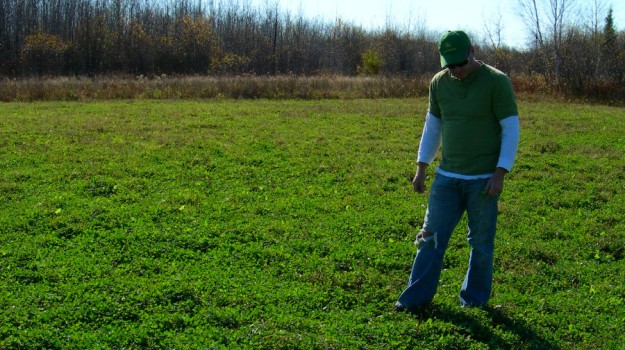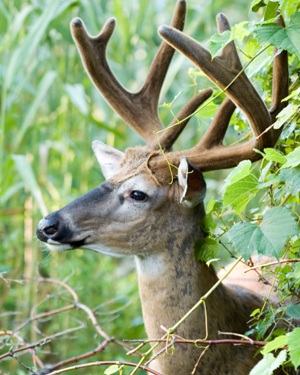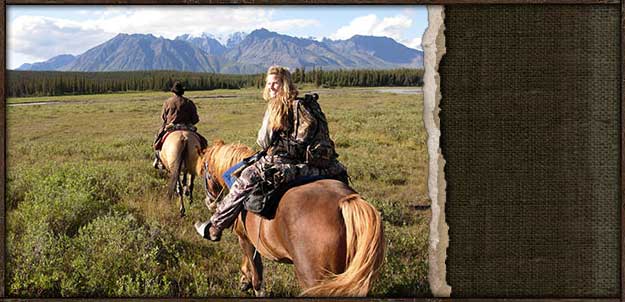
Deer Supplementation Concerns For Summer Antler Growth
By Bobby Deeds / Wildlife Biologist
Summer is here and antler growth is in full swing. We often forget about the nutritional requirements required by whitetail deer during the dog days of summer. June –August is typically one of the most stressful times on whitetail deer due both heat and the increased nutrient demands of antler growth on bucks and lactation on doe. Fawn survival during this time also aligns directly with the nutritional plane available for whitetail doe. Lactating does have the highest nutritional demand of any animal in the herd, including bucks growing antlers. It is also important to remember that the better job we do feeding a doe while she is raising a fawn the better the fawn will be when it is mature. If we nutritionally stress a fawn at an early age they will never be as big as they are genetically predisposed to be. Fawn nutrition is often overlooked by most managers, but it can be one of the most limiting nutritional factors in a management program.
The major nutritional deficiency from a supplementation standpoint for bucks through the summer is a need for more energy in the diet to meet the demands of antler growth. Antler growth will increase the energy requirement of a buck by as much as 23%. It is important to remember that body condition will always take precedence over antler development. Other nutrients like protein, minerals and vitamins are all important to mature deer from an antler development standpoint, but we have found that energy is often most limiting from a supplementation standpoint.
 During a normal year protein often gets more emphasis as a “silver bullet.” During antler growth and lactation, providing a supplement that is 20% protein is more than sufficient to bridge the nutritional gap that may be lacking in native vegetation during the summer. Managers with intensive feeding programs typically utilize a 20% protein pellet starting in March and feed through the first part of September. During the fall and winter months 16% is typically used strategically to meet nutritional requirements which may be lacking.
During a normal year protein often gets more emphasis as a “silver bullet.” During antler growth and lactation, providing a supplement that is 20% protein is more than sufficient to bridge the nutritional gap that may be lacking in native vegetation during the summer. Managers with intensive feeding programs typically utilize a 20% protein pellet starting in March and feed through the first part of September. During the fall and winter months 16% is typically used strategically to meet nutritional requirements which may be lacking.
Even with lush range conditions, deer will still utilize a palatable supplemental feed as a portion of their diet. Supplements that are provided should be just that, a “supplement” to good habitat and not a substitute. Often we look for ways to substitute what mother-nature is providing versus utilizing supplements that will complement good habitat.
Deer will always prefer to consume lush browse and forbs over most pelleted supplements, but just like good habitat, it is all about diversity, supplements should be provided year round in order to achieve the desired results. The major nutritional issues managers should be concerned with is supplementing energy and improving the rumen environment so deer are able to get more out of their native habitat. We often forget that deer are ruminant animals that are designed to digest fiber.
Considering this, the first thing any hunter or manager should consider is how a particular supplement will influence the rumen environment. Improper mineral ratios and high starch levels from grains are all pitfalls I see managers consistently fall into. Grains like corn and many mineral supplements that are sold for whitetail deer oftentimes will cause more damage than do good when we consider what they are doing to the digestive system of a whitetail deer. It makes us feel good to see deer consume the supplements we are providing, which is why many supplements sold are simply “candy” that deer readily consume. These could actually be negatively impacting the deer. Many of these types of supplements can cause some big changes to what is happening in the rumen of the deer which is where the majority of digestion occurs.
Diversity of habitat is always first and foremost of what any gamekeeper should consider from a management standpoint. Improving native vegetation, utilizing food plots and providing a supplement that is specifically designed to complement these should be the three main nutritional concerns of a manager. The take home message is still simply this, all the feed in the world can’t replace good habitat.
Good habitat often becomes marginal habitat; though, when the threshold of carrying capacity is exceeded. There is a fine line we have to walk as managers when we are trying to determine the carrying capacity on a particular property. We all would like to see more deer on our properties, but once we exceed the carrying capacity our habitat will start to pay the bill. Many managers often use feed to fill the gap but once we pass the threshold we see measurements like field dress weights and antler mass of mature bucks start to be negatively impacted. Not having sufficient forage to carry your herd could have many implications, but in extreme cases we will even start to see does not breeding due to poor body condition, lower fawn survival, and increased post rut mortality.
With feed prices at an all time high, it is important that you are providing supplements that are designed specifically for your deer and have the science to back it up. Remember, you want energy that is coming from fat and fiber not starch and sugar, and that the supplement you are using is specifically designed for whitetail deer. Consistent palatability is a key to achieving results and managers should provide the most palatable balanced supplements they can.
 Deer are able to select between forages by the effect that they will have on the rumen environment. Positive post-ingestive feedback is one of the main stigmas that deer utilize to select their diet. Improved intake translates into improved body condition and mass on your bucks as well as increased fecundity for your doe. It is hard not to get lost in what to supplement with, as most deer feeds all claim to be better than others. While most will provide some form of sound nutrition for your deer, the deciding factor should be consistent palatability and results.
Deer are able to select between forages by the effect that they will have on the rumen environment. Positive post-ingestive feedback is one of the main stigmas that deer utilize to select their diet. Improved intake translates into improved body condition and mass on your bucks as well as increased fecundity for your doe. It is hard not to get lost in what to supplement with, as most deer feeds all claim to be better than others. While most will provide some form of sound nutrition for your deer, the deciding factor should be consistent palatability and results.
My best advice to managers is to simply let their deer decide and offer several supplements and see which is preferred the most consistently. Most ruminant animals do not have what we would call “nutritional wisdom,” but I believe whitetail deer are the exception to this rule as they are able to experience feedback from a meal much more quickly than other ruminants and associate that with the consumption of a particular forage or feed.
As managers, nutrition is one of the variables that we can greatly influence with today’s advanced deer feed supplements. In a perfect world we would all be knee deep in diverse, nutrient dense forage that is being provided by our native habitat and food plots year round, but this is simply not the case. Until the day we are able to control precipitation, maintaining an effective supplementation program is crucial to ensure you are able to bridge the gap when times are bad and also allow your deer to get more out of what their habitat is providing.
Buck photo by Bruce Macqueen
Doe and fawn photo by Guy Sagi | Dreamstime






























